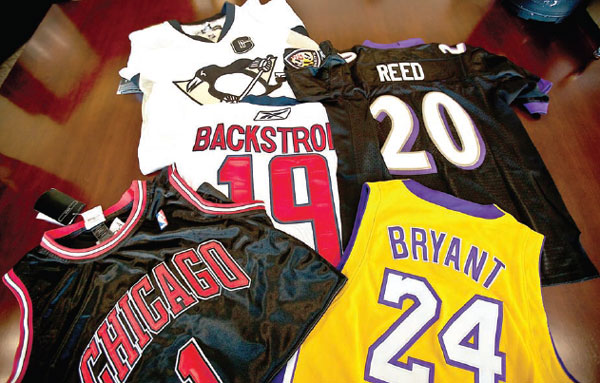Supply, Demand Boom for China's Fakes
Updated: 2015-02-13 11:53
By Amy He(China Daily USA)
|
||||||||
Despite more and larger seizures of counterfeit goods in the United States, the flow doesn't stop. And China, the world's largest manufacturer of goods, is by far the largest source of fake goods, reports AMY HE from New York.
On a wintry afternoon in February, a number of Chinese men and women huddle in front of a Starbucks on the corner of Centre and Canal streets in New York's Chinatown.
Wearing thick scarves and down jackets to keep them warm, the men sit on a railing outside the coffee shop; the women chat among themselves. Walking past the women, one can hear them repeatedly muttering: "Pocketbooks, handbags, jewelry."
If any interest is demonstrated, they pull out folded laminated menus filled with pictures of bags - Louis Vuitton, Chanel, Michael Kors and more - all available for cash and all fakes.
A large Louis Vuitton Neverfull bag costs $120; retail price: $1,340. An Herms Birkin is $150; retail starts at $5,000.
For years that street action has been repeated every day in Chinatown and nearby Canal Street for a willing audience of buyers, almost all of them tourists who want the same thing: copies of trendy and expensive designer bags, sunglasses, watches and other goods.
The bag men - and women - in Chinatown are easy to find. If they can't be spotted on the street with or without the goods, the Internet can help with numerous articles: A Guide to Buying Fake Handbags in New York City and Here's How to Buy a Fake Bag in Chinatown.
One article tells would-be buyers that "it might be best to act relatively quickly" because of Manhattan Councilwoman Margaret Chin's effort to make buying counterfeit bags illegal.
That warning was in 2013. Chin's effort went nowhere, though she says she's still trying to get the City Council to pass what would be the country's first law to criminalize the buying of counterfeit goods by buyers, not just sellers. Chin said that the city loses $1 billion in tax revenue from counterfeits.
Flow increases
Despite large and more frequent seizures of counterfeit goods, the flow into this country is increasing. And despite rising labor costs and China's desire to shift from being solely a manufacturing-based economy, the country remains the world's biggest producer of manufactured goods and fake goods.
According to the United Nations Office on Drugs and Crime, almost 70 percent of all counterfeits seized globally from 2008 to 2010 came from China. For the United States, US Customs said 87 percent of counterfeits seized originated in China. In terms of value, the UN estimates that East Asia exports approximately $24 billion worth of counterfeit goods every year.
For 2015, the International Chamber of Commerce projected that the value of global trade in counterfeit and pirated goods is $1.77 trillion, according to the International AntiCounterfeiting Coalition Inc (IACC). The Washington-based non-profit is devoted solely to combating product counterfeiting and piracy. IACC says its members include small to large multinational companies in automotive, apparel, luxury goods, pharmaceuticals, food, software and entertainment.
In addition to tax revenues, the counterfeiters strip earnings from authentic retailers and companies.
Intellectual property (IP) and brand experts say that not much has changed in regards to counterfeits. The global economy will always run rampant with fake goods from China, they say, and US-China efforts to combat the problem have not yet yielded significant results. The experts say that there's not a lot of incentive to enforce IP protection in China on a local level, and even if there is a desire on a national level, the sheer volume of IP infringements in the country makes it difficult for authorities to crack down on the issue completely.
"There are two things that are happening in China that are unique to the country and that causes the problem of counterfeiting to be bigger in China," said Greg Miller, president of brand security at OpSec, a brand protection company.
"Most of the leading brands have things that are outsourced to a Chinese manufacturer, so the supply chain for authentic goods is all throughout China for a tremendous amount of the global economy. That same ecosystem supports counterfeiters either directly - leakage of product out of a legitimate supply chain - or indirectly, relying on local manufacturer expertise to set up illegitimate manufacturing sites," he said.
And the second thing is the Internet. Customers now have easier access to retailers - authorized or not - who are selling these products, Miller said.
"If you can think of something, it's been counterfeited," said Kim Ciccolella, assistant chief of the international mail facility at John F. Kennedy Airport in New York City, which processes all arriving international mail for the United States.
Sports memorabilia are perennial counterfeit favorites, she says.
Just days ahead of the Super Bowl on Feb 1, federal authorities and the National Football League seized more than $19.5 million worth of fake sports memorabilia, a culmination of a year-long crackdown that began after the Super Bowl in 2014.
Most of the 325,000 goods seized were manufactured in China and then brought into the US through various smuggling networks, according to the US Customs officials involved in the seizure.
Western brands
The counterfeit problem started years ago when Western brands made their entrance into China, according to David Chow, professor of law at the Moritz College of Law at Ohio State University. "Thirty years ago, there was no counterfeiting in China because there were no multinational brands. But 25 years ago, when that began, then you began to see it. By the end of the 1990s, you saw a lot of counterfeiting in China, and it hasn't really gone away," he said.
Millions of parcels leave Chinese ports every day, and the Chinese don't have the resources to screen everything, nor are they particularly interested in doing so because once the products leave, they become another country's problem, Chow said.
"China doesn't really believe that counterfeiting is harmful to China or that cracking down on it would hurt local economies and local businesses more than just letting it continue to exist. It's especially the export of counterfeit goods that are of little concern to China, because once you export those goods, they leave the country and they wind up somewhere else, so they don't think about the harm that might be caused to China," Chow said.
Richard Sybert, senior partner and chair of Gordon Rees LLP's intellectual property practice group, said that it benefits local governments to encourage counterfeiting.
"Counterfeiting provides a source of income and it provides jobs. And especially once you're away from the big modern cities in China - a lot of the rural economies have collapsed. There's a lot of poverty in China in light of the flight of industry and population to the coasts, so there's a tremendous incentive and vested interest in local governments in encouraging and even supporting counterfeiting," he said.
Government officials can also get indirect benefits from counterfeiting, according to Peter Yu, director of the Intellectual Property Law Center at Drake University Law School.
Ports can charge fees for storage in warehouses and can levy taxes on goods leaving the port, which doesn't discriminate over whether the goods are legitimate or not, he said.
"Think about the Yangtze River. If you are counting on the volume of goods going through your port, it does not matter whether they're legitimate products or counterfeit products," Yu said. "It's very attractive if you're charging the taxes or the fees based on the volume of goods."
IP laws
Since entering the World Trade Organization (WTO) in 2000, China has adopted intellectual property laws that are consistent with international standards. Prior to that, the government had established IP laws to be on par with the Trade-Related Aspects of Intellectual Property Rights agreement, which is administered by the WTO and lays down the minimum standards of IP regulation for member countries.
"If you look at the laws on the books, China at the national level has a pretty good set of IP protection laws, especially regarding trademarks, which is your primary line of defense against counterfeits. The laws on the books are good - the national government is actually making and has made some serious good faith efforts," said Sybert.
The challenge, however, is enforcement of the laws and setting up effective deterrents that will discourage counterfeiters from committing the crime, he said. Both Chow and Sybert said that the country will regularly work with multinational brands to conduct raids and seize counterfeit property, but they said doing so has no meaningful impact on the criminal activity because the penalties often are not serious enough punishment to deter counterfeiters.
"The civil penalties or criminal penalties for counterfeiting under Chinese law are just too low. They're so low that you can pay them and still make more money from the counterfeiting," Sybert said.
If the penalty for getting caught at counterfeiting is $100,000, for example, and counterfeiters make many times more than that on a weekly or monthly basis, the fees are not big enough a threat to stop counterfeiting, they said. "We have seen repeatedly that enforcement efforts don't have much of an impact. They'll pay the fines, and they'll set up shop two days later across the street," said Sybert.
As to brands protecting their products being counterfeited, OpSec's Miller said that companies have gotten immensely savvier. They work with brand protection companies like his to monitor the Internet for counterfeit goods being sold on e-commerce sites, verify the authenticity of the goods they come across and shut down marketplaces selling fake ones.
Brands need to track their distribution chains in China to make sure products are being made where they're supposed to, and getting distributed where they're authorized to do so, Miller said. Things are put on labels on the authentic goods that are difficult to counterfeit, and that helps not only customs officials but consumers verify the products' authenticity.
As to what the US can do, authorities say the sheer volume of cargo and parcels arriving at the country's ports is a problem. The JFK International Mail Facility in New York processes 500,000 to 600,000 pieces of international mail a day, and Customs and Border Protection (CBP) can only examine so much. Mail from the Chinese mainland, Hong Kong, and other countries and regions are targeted and a percentage of all mail is checked by experts and agents on hand, according to the CBP's Ciccolella.
Express mail parcels - where the majority of IP infractions occur because of the quick delivery time and the ability for buyers to track their packages - are scanned by an X-ray system. Packages that are suspected of IP violation get appraised by on-site experts. If the contents are determined to be counterfeit, they get turned over to the seized property division before being destroyed.
Buyers are notified of seizures and given an opportunity to offer proof of authenticity if they feel their package was wrongly seized. Most people - Ciccolella estimates 99 percent - don't petition and just forfeit their packages.
Counterfeiters don't make too much of an effort to conceal their packages beyond purposefully mislabeling the contents on an invoice, or just saying that a package is a "gift" for the receiver. "For the most part, there's no concealment; you open it up and right there are the products," Ciccolella said.
Shippers often send goods to individual buyers, who are most likely buying products off the Internet without realizing they're fake.
"A lot of individuals would think that because they're buying something online, it's genuine, or they think that it's getting shipped from China so they're getting a good deal, not realizing that when it's so much cheaper than the actual product, it's going to be counterfeit," she said.
If customs agents notice large shipments going to individuals or businesses, or shipments going to repeat individuals, they will notify Homeland Security Investigations (HSI), which will conduct their own examinations.
"It's difficult from an investigative standpoint - if it goes to an individual, for example, I can get 20 boxes, my cousin can get 20, my friend gets 20, you won't see them on the street or sold at flea markets," Ciccolella said. "We do get boxes of 50 or 60 watches, so it's unlikely that that will be for personal use. But if it goes to individuals, it goes to different individuals. And it's not only local - it comes in here and then it gets shipped out to other states as well."
IP violations
The most recent figures from the Customs and Border Protection for 2013 show that intellectual property rights violations seizures increased 7 percent from those in fiscal year 2012. The total manufacturer's suggested retail price (MSRP) of the goods, if they had been genuine, increased 38 percent to $1.74 billion. Of that total, seizures originating from China were valued at $1.1 billion, representing 68 percent of all IPR seizures.
Figures show that IPR seizures have increased approximately five-fold in the last decade, from about 6,000 in 2004 to nearly 25,000 in 2013.
Ciccolella said that customs officials at JFK will work with those from other ports around the country on operations. She said that Chinese customs officials have toured the JFK mail facility and told US agents that they examine all outgoing mail leaving China.
"I'm not really sure how it's possible since we get so many counterfeits. They said that they make every effort to stop it from reaching the United States," she said.
But at the same time, the experts said that there is a limit to how much China, and the US, can do to combat the pervasiveness of counterfeiting. Regions in China that have been more active in protecting intellectual property rights are not always the places that are manufacturing and moving large amounts of counterfeit goods out of the country.
"If you look at China, it's a large country. A lot of the developments in the IP areas are in the coastal areas and a lot of this development has not trickled down to the other parts of China, where there is still a lot of production of pirated and counterfeit materials," said Drake Law's Yu.
The US and other Western countries that complain about counterfeiting often view China as a large, centralized government, and thus take complaints directly to Beijing, not realizing that authorities in Beijing that make decisions in the city might not necessarily affect those on the opposite side of the country, Yu said.
Sybert similarly said that central authority dissipates once you're away of the big cities.
"The old Chinese saying that, 'The sky is high and the emperor is far away.' The popular perception in the West is that somehow China's this monolithic, totalitarian, authoritarian society where everything is controlled. That absolutely is not the truth. A hundred miles outside of Shanghai or Beijing, and to some degree, the central government no longer exists. It's a big, fissiparous country," he said.
Courts overwhelmed
Much of the judicial structure in China is also overwhelmed by the number of intellectual property cases it sees in court, Sybert added, and the government tries to staff and fund them adequately, "but there's just too much and they continue to get backlog."
Mary LaFrance, professor of law at the William S. Boyd School of Law, said that enforcement is hindered by a bureaucratic system that has trademark owners pursuing relief at a local rather than a federal level, and that local enforcement systems are "cumbersome and inconsistent".
But despite some calling China's efforts inadequate, no country on Earth has made as many advances in their legal system where intellectual property is concerned, and in such a short amount of time, Yu said.
"China at the moment is probably the most litigious in terms of IP protection, so if you actually look at the number of cases that has gone before the Chinese court and the number is actually higher than all the other countries. If you look at the number of people that have been devoted to IP enforcement, it's also the highest in the world," said Yu.
"So I think to some extent it's hard to just say that China has not been doing enough. Because at some point, you just have to ask: how much can they actually do if you're already No 1 in the world in terms of IP cases that have gone before the court? No 1 in the world in terms of enforcement?"
Back at Centre and Canal streets in Chinatown, the passerby turned would-be buyer has chosen a bag and is told "follow me" and waits outside a hair salon a short distance from the Starbucks.
After no more than five minutes, the seller brings back the item and tells the buyer to examine it. The price is $120. The buyer offers $70. The seller counters with $85. "That's the best I can do," he says. But the buyer insists on $70, and then tells him to forget about it, that she'll look elsewhere. "Fine, I can give it to you for $70. But just know that I rarely do that. I'm doing it just for you."
Contact the writer at amyhe@chinadailyusa.com
|
A display of counterfeit jerseys for National Basketball Association teams seized by US Customs and Border Protection. Provided To China Daily By Us Customs And Border Protection |
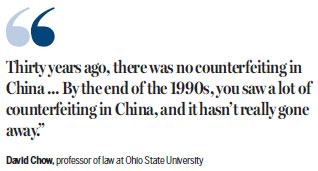
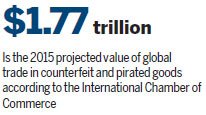
(China Daily USA 02/13/2015 page20)

 Clown therapy for sick children
Clown therapy for sick children
 Top 10 box-office countries in 2014
Top 10 box-office countries in 2014
 Spring Festival reception held in Vancouver
Spring Festival reception held in Vancouver NC slayings spark Muslim outcry
NC slayings spark Muslim outcry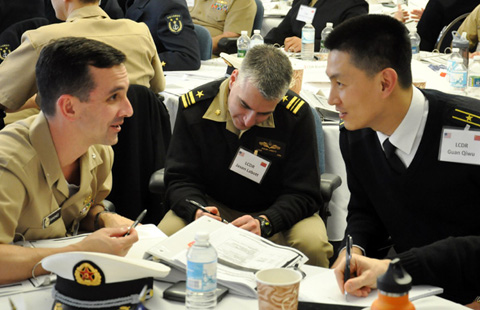
 Chinese navy officers find value in US visit
Chinese navy officers find value in US visit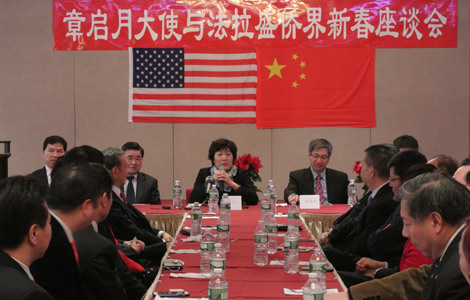
 Consul general weighs in
Consul general weighs in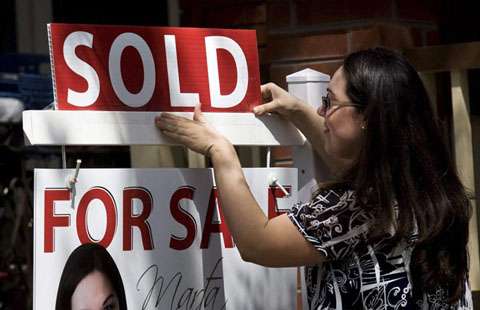
 10 destinations favored by Chinese property investors
10 destinations favored by Chinese property investors
 Spring Festival goods in the making
Spring Festival goods in the making
Most Viewed
Editor's Picks

|

|

|

|

|

|
Today's Top News
Car crashes into US Consulate in Shanghai
China plans quality growth, anti-graft drive in 2015
US must help to safeguard cyber security, Beijing says
Obama seeks new war powers
US has 'risen to the challenge' of fighting Ebola
Obama asks Congress to authorize military force against IS
NYC police officer charged in stairwell shooting
Investors shifting focus in global realty purchases
US Weekly

|

|
